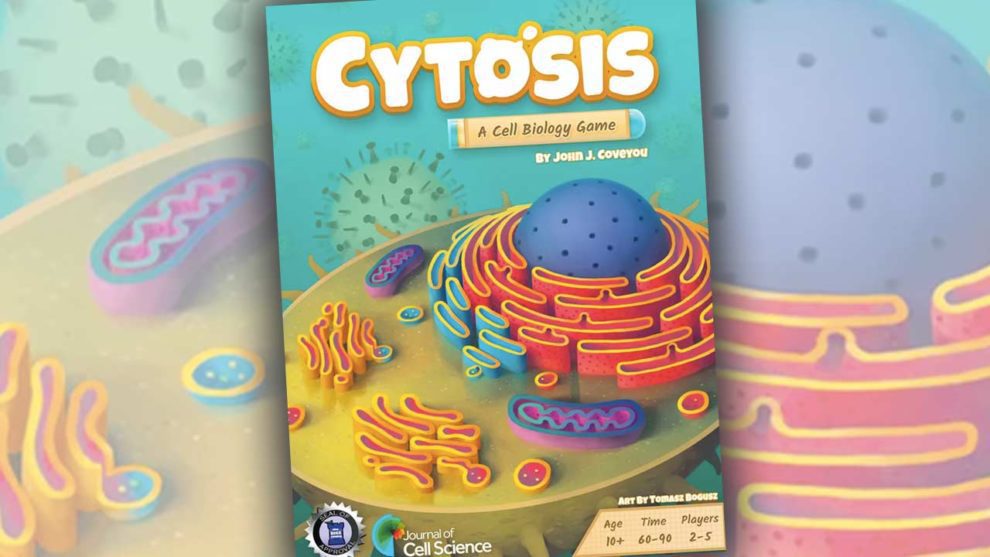Disclosure: Meeple Mountain received a free copy of this product in exchange for an honest, unbiased review. This review is not intended to be an endorsement.
Oveview
The process of cytosis is the method by which a cell intakes material for its survival then expels it. Simply stated, when the cell takes stuff in, it surrounds the object and entraps it in a bubble called a vesicle. The vesicle is responsible for ingesting and disposing of everything contained within it. The game of Cytosis attempts to reconstruct this process in a way that is fun, challenging, and educational.
Cytosis lasts for a number of rounds determined by player count. In the game, the players will be competing to obtain and complete different types of cell component cards that award victory points in various ways. Each player has several workers at their disposal and these workers will be used to select various actions from the game board in order to complete the criteria required to play their cards. When the game is finished, the player who has scored the most “health points” (HP) will be the winner.
Components
The game of Cytosis includes a large, brightly colored game board, several decks of cards, 5 sets of worker meeples in different colors with an additional 2 grey worker meeples, 10 transport disks (2 per color), and 15 player markers (3 per color). The cards are divided into several types: Goal cards, Event cards, and Cell Component cards. There is also a hefty supply of blue ATP tokens and multi-colored Macromolecule (green carbohydrate, yellow lipid, black mRNA, red protein) cubes.
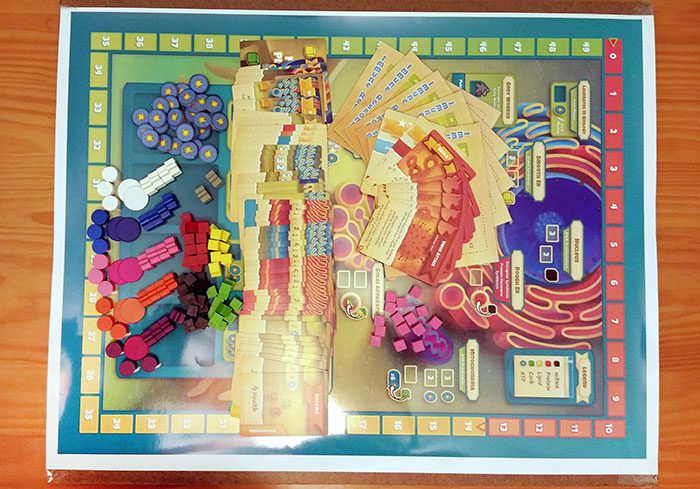
The preview copy that I received also also included a small mini-expansion (called the Virus Expansion). The base game may or may not include this expansion, but since it was provided for me, it is worth mentioning it here. Also, as I have not had an opportunity to play with the expansion, this section is the last time that it will be mentioned in this review. The Virus expansion comes with its own set of Cell Component cards, Event cards, and Goal cards. The expansion also includes 5 dice and 15 pink Antibody cubes. Unlike the base game, the expansion has player mats that go along with it.
Since this was just a prototype, I cannot reasonably describe the quality of the components as they will appear in the finished product. For instance, the cards in the prototype are pretty flimsy and the game board itself is printed on a roll of paper. I imagine that the final product will be of much higher quality. That being said, the one thing that I CAN comment on is the quality of the art work. Tomasz Bogusz has done a good job here of illustrating the various components in bright, vivid colors. Everything feels friendly and inviting. A lot of educational games are, by their nature, very clinical and overly detailed. It is obvious that the artist has taken great pains to avoid this here while also accurately representing the various concepts that the game introduces. Because of the artwork, Cytosis has a very pleasing table presence.
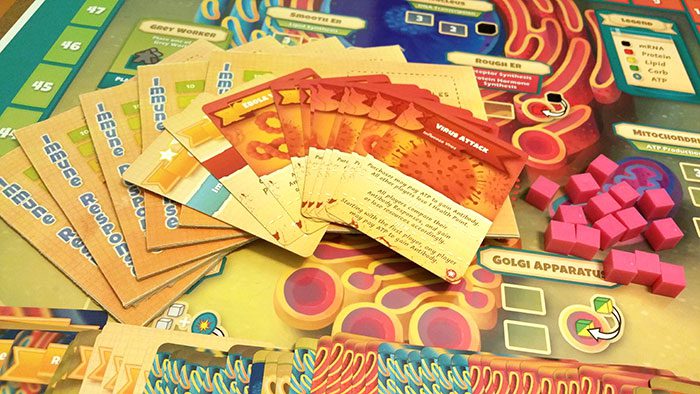
The Cards
The Goal cards have a title across the middle describing the main cell component card type that the goal is associated with. At the bottom of the card, there is room for 2 player markers. When a player claims the goal, their player marker is placed in this spot. Once there are two player markers on a goal card, no more players can claim the goal. Finally, beneath the title, there is an area of text that describes what the actual goal is. For example, the “Enzymes” goal awards the player with 2 bonus HP for each Enzyme card that they have completed during the course of the game.
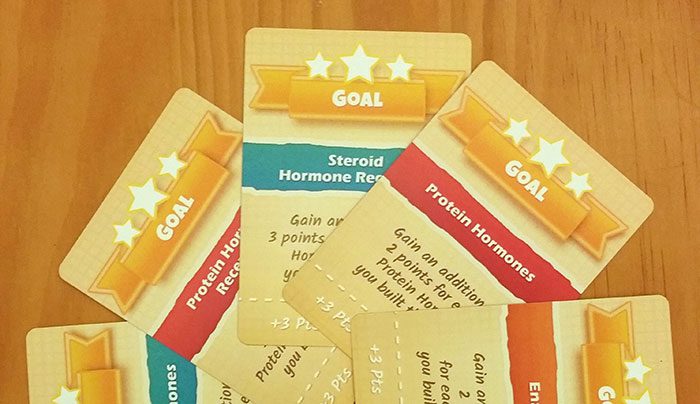
The Event cards have a title at the top of the card with an accompanying illustration describing the type of cell component affected by the event. At the bottom of the card is an area describing just what the event card does. Most events are helpful in nature, but can occasionally be negative. For instance, the “Respiration Boost” Event card adds an extra ATP token to the Mitochondria space for the duration of the following round.
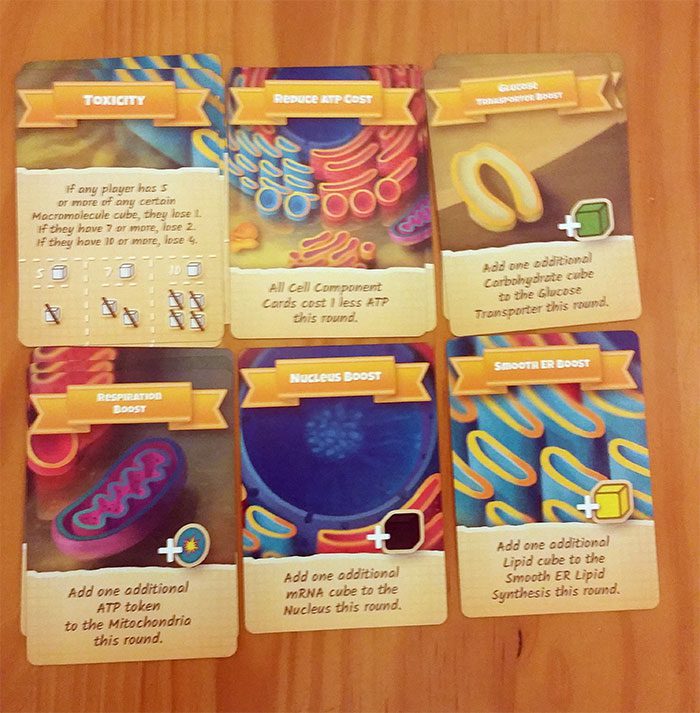
There are 7 different types of Cell Component cards (Protein Hormones, Protein Hormone Receptors, and Detoxification to name a few). Each of the different types of cards will award HP or resources in some way. At the top of each card is the card’s name. If the card interacts with a specific area of the game board, there will be an illustration on the card coinciding with the card’s target area. If the card has an ATP (this is the monetary unit in the game) cost associated with it, that cost will be shown on the left side of the card. Any Macromolecule costs/rewards will be shown to the right of this. The HP scoring conditions are shown along the bottom edge. I will discuss a few of these different types of cards in detail later to give you a general idea of how the cards might affect your strategy.

Setup
At the beginning of the game, each character will select a color and take the pieces of the color that they have selected. The game board is laid out and the players will place one of their marker tokens onto the 0 space of the scoring track. The Macromolecule cubes are placed in a pile closeby along with the ATP tokens. The Cell Component and Event cards are separated by type, shuffled, and placed face down closeby to form draw piles. Depending on the player count, some Event cards might have to be removed from the game. 3 to 5 of the Goal cards are selected randomly (also dependent on the player count) and placed along the top edge of the game board. Four Cell Component cards are then flipped face up and placed into the Cell Component card area of the game board.
Once this initial setup has been completed, a starting player is selected and they receive the First Player card along with 2 ATP tokens. Then every player, in clockwise order, receives the same amount plus 1 ATP token for every player that received ATP tokens before him. Each player will also receive 3 Cell Component cards, select 1 to keep, and shuffle the remainders back into the Cell Component card deck. You are now ready to begin playing!

The Actions
During a round of play, each player will take turns placing one of their worker meeples at a time onto the various action locations on the board. Each location will have a certain number of spots onto which a worker meeple may be placed. Only one worker can be placed in each delineated spot. Once every player has placed all of their workers, a cleanup phase takes place in which the players collect their spent workers, refresh the board, and introduce a new event before continuing on to the next round.
Describing the game board is more easily achieved by discussing the various actions that the players will have available to them throughout the course of the game. Since completing some of the Cell Component cards is a multi-step process, I will discuss those particular actions in order using this naming convention “ActionName part 1”, “ActionName part 2”, etc. so that you can easily see how they are associated. The various actions are:
Resource collecting actions
Nucleus (DNA Transcription): allows you to collect a 2-3 mRNA cubes.
Plasma Membrane (Glucose Transporter): allows you to trade 1 or 2 ATP tokens from 1 to 2 Carbohydrate cubes.
Mitochondria (ATP Production): allows you to collect 2, 3, or 6 (By trading in a Carbohydrate cube) ATP tokens.
Smooth ER ability #1: allows you to collect 2-3 lipid cubes.
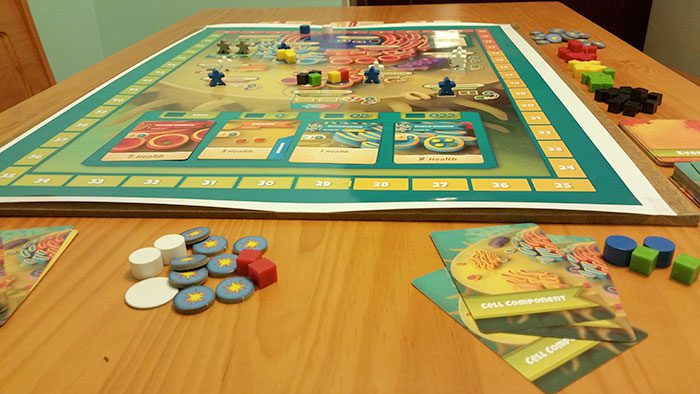
Card completion actions
Free Ribosome (mRNA Translation – Enzyme card part 1): allows you to convert any number of mRNA cubes into Protein cubes.
Cytoplasm (Enzyme Synthesis – Enzyme card part 2): allows a player to play an Enzyme card from their hand. After paying the required amount of ATP and cube costs, the player will receive the amount of HP shown on the card.
Smooth ER ability #2 (Alcohol Detoxification): allows the player to pay the ATP cost of an Alcohol Detoxification card and earn 1 immediate HP.
Smooth ER ability #3 (Steroid Hormone Synthesis – Steroid Hormone card part 1): allows a player to place one of their transport vesicle disks onto the board along with any number of Lipid cubes from their personal supply.
Rough ER (Protein Hormone and Hormone Receptor synthesis card part 1): allows a player to place a transport vesicle disk ono the board and then convert any number of mRNA cubes into Protein cubes. These Protein cubes are then placed onto the transport vesicle disk.
Golgi Apparatus (Steroid Hormone, Protein Hormone, Hormone Receptor card part 2): allows a player to move one of their transport vesicle disks from either the Smooth ER or the Rough ER to one of the spaces beside the Golgi Apparatus action and then place either one Lipid cube or one Carbohydrate cube from their supply onto the transport vesicle disk along with the cubes that are already on it.
These Receptor cards, when completed, will earn HP every time any player completes Hormone cards that they are receptors for. For instance, the Steroid Hormone Receptor awards HP every time anybody at all completes a Steroid Hormone card. In fact, the more of a certain type of Receptor card that you’ve completed, the greater the number of HP you’ll receive each time its matching Hormone card is completed.
Plasma Membrane (Exocytosis – Steroid Hormone, Protein Hormone, Hormone Receptor card part 3): allows a player to move a transport vesicle disk from the Golgi Apparatus to a space beside the Plasma Membrane action. Then the player reveals a card from their hand matching the layout of the cubes that are on their transport vesicle disk. After paying the associated ATP cost, the player receives the HP shown on the card. The Macromolecule cubes are returned to the general supply and the player collects their transport vesicle disk.

Other actions
Grey Worker: allows the player to pay 4 ATP, before placing their worker as normal, and place one of the grey worker meeples anywhere. A player can only use this action once per turn. Then they place their own worker as normal.
Laureates in Biology (First Player): the player selecting this action receives 1 ATP token OR can place one of their player markers onto any available goal card space (scoring 3 HP if they are the first person to select that goal). Then they also receive the First Player card.
Purchasing Cell Components: the player selecting this action will choose a card from the tableau, pay its associated ATP cost, and then place the purchased card in their hand. The prices for cards range from free to 3 ATP.
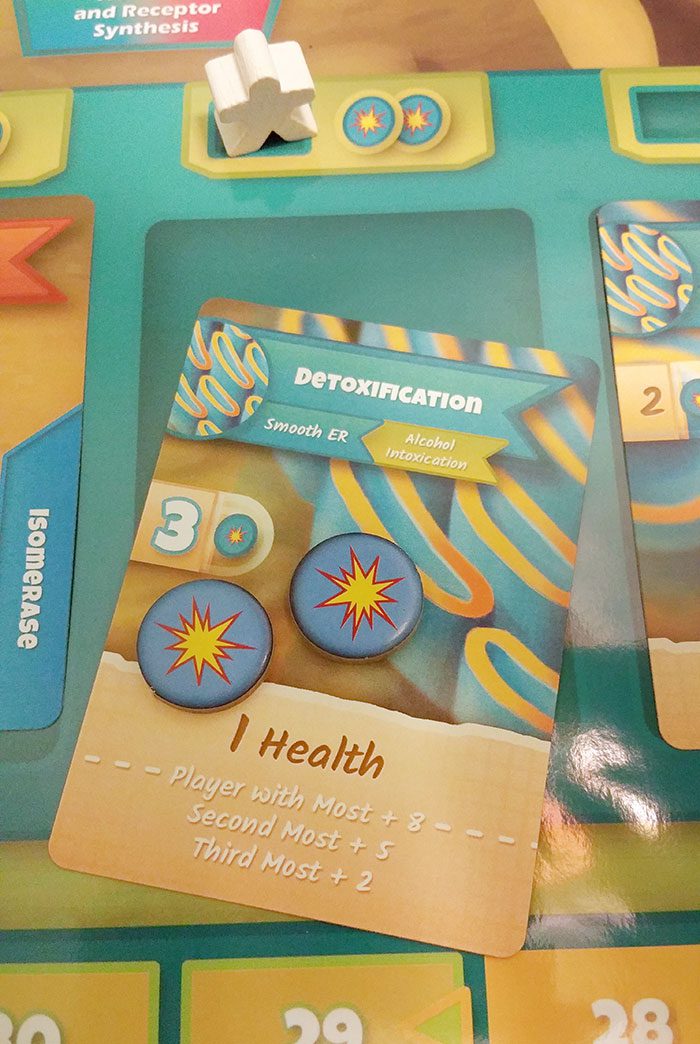
Refresh and Game End
After every player has placed all of their workers, a refresh step is performed. First, the players get all of their worker meeples back. Then an Event card is flipped over and the players do whatever the card says. This new Event replaces any previous event. Next, the cheapest card in the Cell Component card row is discarded. Any existing cards slide all the way to the left and then cards are drawn from the Cell Component card deck to fill in the empty space. The game continues in this way until the last Event card is flipped face up. This signals the beginning of the last round of the game. When that round finishes, the players will tally their total HP to determine the winner.
Bonus points are awarded for goals met (from player markers that have been placed onto Goal cards), sets of Enzyme cards collected (there are multiple types of Enzyme cards), having the most Detoxification cards completed, and 1 point for every 3 Macromolecule cubes of the same type in the player’s personal supply.
Thoughts
As far as worker placement games go, Cytosis isn’t anything new or innovative. You place workers and you take actions with them to earn victory points. It’s very standard and by the book. However, Cytosis isn’t your every day board game. It’s an educational game designed for teaching.
So, let’s deal with the obvious instinctual reaction to hearing the phrase “educational game”: namely, the urge to go do something else. Educational games aren’t known for being very fun or engaging. It’s very rare to find an educational game that manages to find that sweet spot between teaching you and also being entertaining. So, on which side does Cytosis fall?
It is definitely one of the latter. Without knowing anything at all about the process of cytosis, you could play this game and then be able to reasonably explain in detail just what that process entails. Cytosis manages the neat trick of distracting you with its game-iness (is there even a word for this?) while sneakily drilling knowledge in the center of your brain. As far as being an educational game that’s appealing and engaging, Cytosis performs brilliantly.
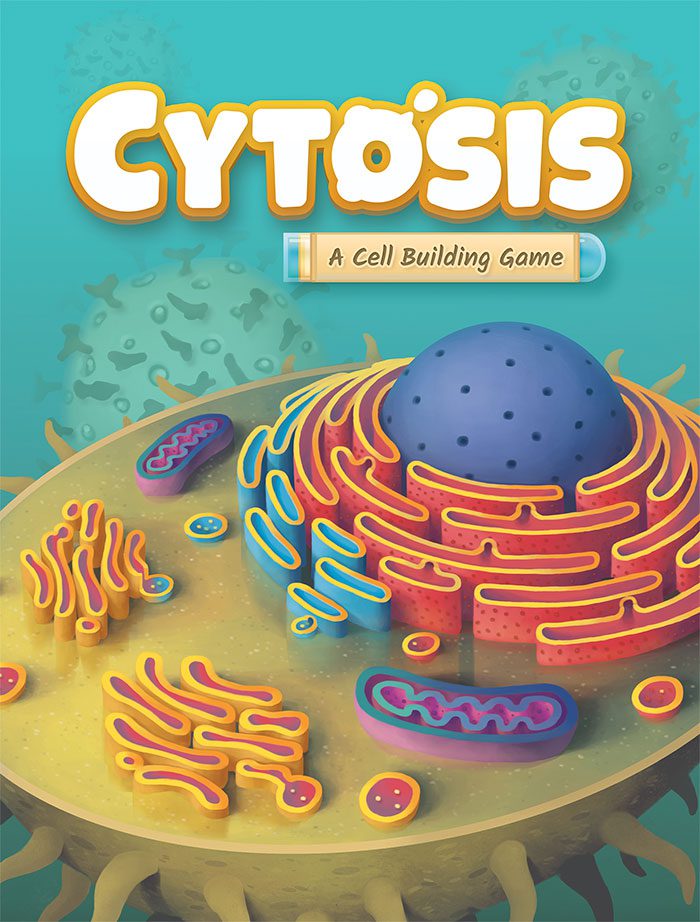
There’s definitely a game here though. It’s got plenty of that going for it, too. There are multiple paths to victory and deciding which one to follow isn’t always an easy decision. Early on in my first game, I had decided to focus on cranking out all of the Hormone cards that I could. I was hoping to steadily crawl my way up the HP track and possibly grab up the appropriate Goal card to maximize my HP potential. However, that plan quickly fell through when it became obvious that my wife was going for the same goal. That meant I had two choices: continue down the path that I had already selected or change course completely mid-game.
Looking at my options, I noticed that I had one Enzyme card already completed and that there were at least two more in the Component card row. However, I had been collecting Macromolecule cubes that were primarily needed by the Hormone cards. So, I changed course. I went for the Enzyme cards and I made sure to grab the Enzyme bonus for a quick 3 HP and the hopes of even more HP when the game was done.
For being an educational game about cytosis, this is a game rich in these kinds of decision making and that’s why Cytosis is able to transcend the negative stigma that surrounds the games in the game space which it occupies. I have been consistently impressed with John Coveyou. I have no idea how he is able to look at some convoluted biological process and make a game out of it, but I’m glad he does. I really enjoyed playing Cytosis. I found it to be aesthetically pleasing, educational, engaging, and entertaining. Color me impressed! I’m fairly certain you’ll be impressed, too!
What do you think about Cytosis: A Cell Biology Game? Give us your opinions about what you like and/or dislike about the game in the comments below!


